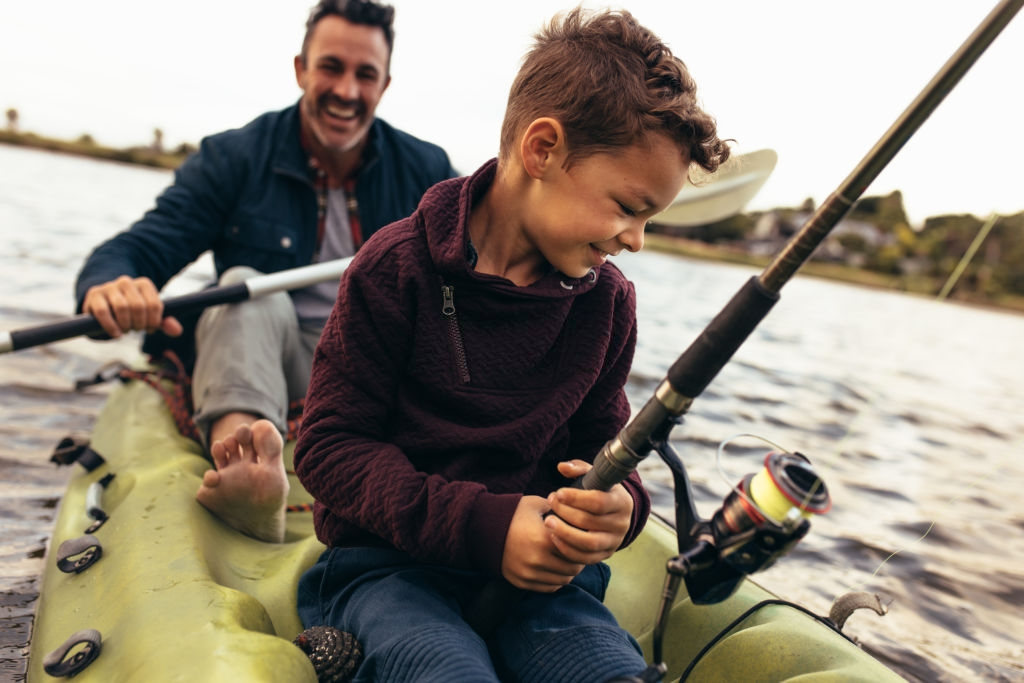
Essentially there are 2 styles of kayaks.
Sit On Tops (SOT) and Sit In Kayaks (SIK) are these. Each sort has well-fished versions. Until we discuss the merits and drawbacks of each form let’s discuss fishing kayaks in general first.
Who makes a kayak a decent kayak to dive for?
Fishermen often have requirements which may vary from someone who wants to paddle strictly. Some of the basic characteristics that fishermen want in a kayak are durability, safety and enough flat surfaces to add on accessories such as rod holders and depth finders. Performance and maneuverability may not be the primary factors in selecting your first fishing kayak, though they are essential to many.
Begin your decision-making process by answering some basic questions that will help you narrow down the kayak models that fit you best.
- Rate yourself first.
What are your measurements on height, weight, inseam and general condition? If you’re a huge or very large guy, there are some kayaks that’ll be better suited to you. This will actually make the decision easier, because finding the right kayak is more about having one that fits your size and weight than anything else. Search for plenty of leg-room kayaks and a weight ability that’ll accommodate you and your clothes.
If you’re a tiny to average person getting a big, heavy kayak and possessing an ability of 600 pounds is definitely not your best choice. But if you go fishing in the ocean a very tiny kayak would not be the best option either. Choosing a kayak can be a kind of choice as you will see. Look at the various considerations while you read on, and weigh them before making your decision.
- What kind of car will you use to carry your kayak?
When you intend to ship your kayak a larger, stronger kayak does not present a problem in a pickup truck’s frame. Though, if you have a big SUV, like a 4WD Suburban, you should be mindful of the weight of the kayak, because it will take some extra effort to get the kayak on and off the vehicle’s top. The bottom line is you’ll use it more often if your kayak is easy for you to load and unload.
- Where are you planning on using the kayak?
Can the kayak be used in freshwater only? Where if so? Lakes, watercourses, shallow ponds, and creeks? Will you be hunting with plenty of waves and choping large open bodies of water? Planning to use your kayak in saltwater? Planning to hunt in the ocean and kayak through the surf? How do you plan to bring your kayak up to the water? Could you simply drive it to the water and start it, or plan to launch it in remote areas where you can not move your car to the edge of the water? When selecting your kayak all of these considerations are significant.
- Which tools do you like to use for fishing?
Are you just using one style? Using artificial lures, live bait-fish, or both? Do you want to use live bait-fish or dead bait when using food? Want room on your kayak for a live-well? Planning to anchor and chumm? Live fish? Fly fish? The sort of gear you intend to mount and carry along will influence your choice. In short, the way(s) that you fish can influence which kayaks will be better suited to your needs.
- What kind of angler are you?
Are you just a fisherman at catch and release, do you like to take home the occasional meal, or do you take home fish regularly? Where’d you put your catch? Is there space in / on your preferred kayak?
What kayak model would be perfect for you? A Sit On Top or a Kayak Inside?
Sit In Kayaks is the standard Kayak style. The sort that typically comes to mind when most people think about kayaks is this. These are close to canoes in that you’re seated inside the kayak’s bottom hull. Sit ins provides further initial protection from the elements but they can fill with water without the appropriate precautions in rougher environments. These are normally designed with a spray-skirt in adverse conditions. A skirt is a wrapping around you, and the kayak gap that stops water from entering. When using a skirt you may unintentionally restrict access to items inside the kayak, but if you’re a fisherman of the bare bones kind this may just fine suit you.
Sit On Top Kayaks is a modern kayak style. You feel like a tweaked surfboard of sorts and you are lying on them and not in them. SOTs have what is known as scupper openings, enabling water to drain out of the cockpit. This means the cockpit through flood temporarily as water is washed over the kayak but it will quickly drain away without the need to pump out any water. This is particularly beneficial at areas such as the surf zone.
All types of kayaks are valuable to fishermen, and there are variants within each type that will better suit you than others. Let’s get back to some of those earlier questions and see why they’re important to help you select which of those kayak styles will be better for you.
Stability: Fishermen do something that other paddlers don’t do-they catch in a kayak. Therefore it can be very necessary to have a relatively stable forum, particularly for someone new to the sport and new to kayaks. If kayakers are thinking about equilibrium they are talking about 2 forms. Original and 2nd. Original equilibrium is the side-to-side wobble you’ll experience while seated in a kayak. Secondary stabilization is when the kayak reaches its tipping level, and how much grace it has before it finally flips.
Most outdoor kayaks have enormous initial stability but their secondary is very abrupt. You are basically discarded after meeting their secondary cap. Conversely, there are kayaks that wobble like nuts but when they arrive at the dump point they are very accommodating. Many recreational fishing kayaks have strong original as well as secondary stability compromises.
Since you are seated on or close a SIK floor they tend to appear more solid. You are seated on the kayak in SOTs and since it has a double hull you are positioned higher, too. A elevated sitting posture will render a SOT look less secure at first. If you have the same length and width SOT and SIK the SIK would generally be more robust. Thanks to this SOT models prefer to expand their kayaks. So no matter what design you want there’ll be a pattern in which you’ll feel comfortable.
For experienced kayakers, initial stability may seem more essential to newcomers, and secondary stability. It does make sense. The commencer has not yet developed a sense of equilibrium. It is very much like studying how to ride a bike. It’s different when you get going and you worry about it more. It becomes second nature after a little time and you don’t even care about it at all.
Speed: In fact, the quicker a kayak is the wider and narrower it is. SIKs are usually faster but there are also quick SOTs. Speed is important just when you need it. If most of your fishing is near the shore or in remote, protected areas, then you probably won’t need a long quick kayak. Nevertheless, if you’re fishing a large reservoir, lake, wind, or in the open ocean, you may find the ability to cover distance very valuable. An SIK of the same scale would typically be quicker, as it is smaller than a SOT of the same length.
Maneuverability: If you go fishing in shallow creeks or short estuaries, you’ll definitely want a conveniently maneuverable kayak. In these cases, a long fast touring kayak will be easier to use, and may take away the total fishing experience. If these styles of settings do, a shorter SOT or SIK would suit you better. It’s typically not crucial to make a sharp turn on broad waterways so a longer kayak isn’t an issue.
Accessory Friendly: turning a basic leisure kayak into a very powerful and lightweight fishing vessel is one of the delights of kayak fishing. This is accomplished through the introduction of fishing gear. How much you incorporate is largely a function of your fishing style and equipment theory. Many fisherman only carry a rod and a couple of lures along and others like to put along loads of equipment. Whatever your pick, only adding one rod holder can greatly enhance your kayak’s fishability. Plenty of flat surfaces are perfect for mounting accessories.
Storage: Fishermen tend to take along a lot of gear. Organizing this equipment requires proper handling of the kayak you’ve picked. It doesn’t have to be a number but it’s nice to put the things in a couple different places. SOT kayaks have a double hull that means a lot of easy room under the deck. That may be really important to you based on your needs. You can intend on camping in your kayak or on long journeys. This growing, relatively dry region of storage will appeal to you. If you are planning to launch your kayak through the ocean, this room will allow you to store bellow deck rods that will keep them safe while you enter the surf zone. Most SIK’s have hatches providing entry to sealed-off hull compartments. Many of the SIKs that fishermen use also have large open cockpits, which make it easier to get to the equipment that you may have packed around. Milk crates and other plastic containers can also be used for external storage. They match in many SOT kayaks’ tank-wells and can also be tied onto the SIKs floor.
Fishing logistics: Kayak fishing takes place in a variety of environments, with large bays, noises and even the open ocean, but many of us do catch some very tiny waterways. With a quick, lightweight kayak it is very easy to fish a little freshwater channel. It will be easier to negotiate such a kayak through challenges like trees, log blocks, bricks, waterfalls & spillways, swift water, and rough shallows. There will be moments where your kayak needs to be carried or pulled across, across, or through these areas. In these types of situations the better choice is a smaller, lightweight kayak.

